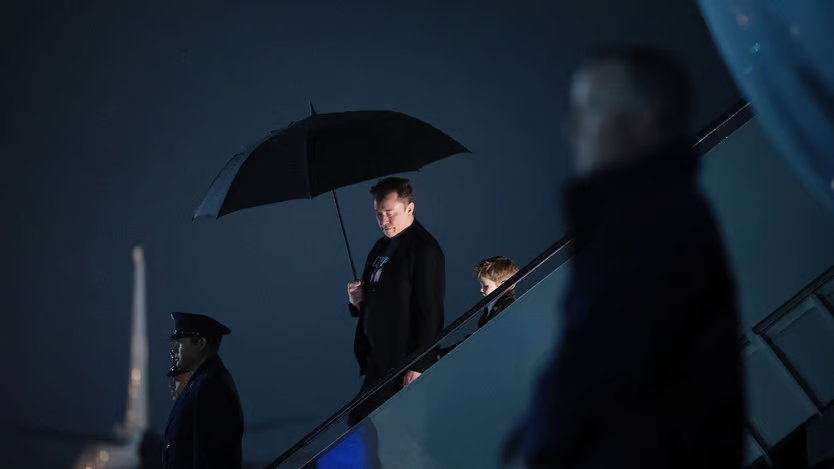The world’s richest man has lost focus. His competitors are taking advantage

UNTIL RECENTLY Elon Musk had little need to look over his shoulder. He once described competition for Tesla, his electric-vehicle (EV) company, as “the enormous flood of gasoline cars pouring out of the world’s factories every day”, rather than the “small trickle” of other EV-makers. SpaceX, his rocket firm, had so undercut and outwitted the bloated aerospace incumbents that it had developed an almost invincible aura.
Yet if Mr Musk can tear himself away from the intoxication of shredding the American government, he may notice something. It is not just that the political firestorms he has whipped up this year are singeing his companies’ brands. It is that the two businesses that underpin his corporate empire—accounting for around 90% of its value and probably all its profit—are facing increasingly stiff competition. The world’s richest man has lost focus—and now has a target on his back.
Start with SpaceX. Last year it conducted five out of every six of the world’s spacecraft launches. Through its Starlink division, it owns 60% of satellites in space. In December it sold shares at a valuation of $350bn, two-thirds higher than its previous level. Starlink, its main profit engine, is on track to generate more than $11bn of revenue this year and $2bn of free cash flow, says Chris Quilty of Quilty Space, a consultancy.
Now, however, Mr Musk’s bomb-throwing interventions are alarming SpaceX customers, and at a time when rivals are growing more capable. His on-again, off-again threats to end Starlink’s support for Ukraine have raised the difficult question of trust. European politicians are pondering how reliable Mr Musk will be as a long-term provider of strategic satellite communications. The search for alternatives has helped spur a more than tripling of the share price of Eutelsat, the French owner of OneWeb, which provides satellite services to broadband companies.
No European supplier could come close to matching the 7,000 satellites Starlink has in low orbit. (Eutelsat has a mere 600.) Nor could any compete on price. As Simon Potter of BryceTech, another space consultancy, puts it, for now the concerns are “more noise than action”. Yet Starlink may soon face meaningful competition from Amazon’s Project Kuiper, which aims to put over 3,000 satellites into low orbit, creating a space-based broadband network. If it achieves that, some customers outside America may decide they have more confidence in an Amazon product than in one belonging to the mercurial Mr Musk.
Jeff Bezos, Amazon’s founder, is also stepping up the pace in the launch business with Blue Origin. His rocket firm is separate from Project Kuiper, but has contracts to fly many of its satellites. In January Mr Bezos’s New Glenn rocket reached orbit on its first try. If Blue Origin manages to make repeated successful journeys with reusable rockets, it could become a meaningful competitor to SpaceX. So could Rocket Lab, SpaceX’s closest rival by number of launches, which is due to debut Neutron, a new rocket, this year.
The threat to Tesla is both greater and more immediate. From a peak of $1.5trn in mid-December, its market value has fallen by roughly half. Activists have been picketing Tesla’s showrooms in America and Europe in anger at Mr Musk’s behaviour. Yet Republicans buy Teslas, too. Protests are only part of the story.
As with SpaceX, Tesla’s competition is revving up. Indeed, the firm’s lead in the EV market was narrowing even before Mr Musk began his bureaucracy-bashing. General Motors sold 50% more EVs last year than in 2023, and is now vying with Hyundai, a South Korean carmaker, to become America’s second-biggest provider of battery-powered vehicles. Although Tesla is still the market leader, RBC Capital Markets, an investment bank and Tesla bull, forecasts that the carmaker’s share of North American EV sales will drop to 53% this year, from 68% two years ago. Profit margins have narrowed as the firm reduces prices to undercut rivals. A recall of nearly every Cybertruck in America owing to problems with the glue used to affix exterior panels will not help.
In China, the world’s biggest car market, the future looks bleaker still. BYD, Tesla’s largest rival, has 15% of the market, more than triple that of the American carmaker. In February Tesla’s sales in China plunged by 49%, year on year, whereas BYD’s rose by 161%. Tesla’s sluggishness may have in part reflected the fact that Chinese customers were waiting for an upgraded Model Y available from February. But BYD has since gazumped it. On March 18th the Chinese firm unveiled a charging system that it said could power an EV in five minutes, half the time of Tesla’s charging infrastructure. Some pundits described it as the car industry’s “DeepSeek moment”.
BYD has also cast doubt on another part of the Tesla bull case: driverless technology. Tesla’s driver-assistance system, which it exaggeratedly calls full self-driving (FSD), is what others call Level 2 autonomy, meaning that drivers must still keep their hands on the wheel and pay attention. Tesla bulls see advancing to Levels 4 and 5, meaning fully autonomous driving, as the next stage in the firm’s quest to revolutionise transport. Tom Narayan of RBC Capital Markets ascribes almost three-quarters of his projected valuation of Tesla to hopes that it will develop fleets of low-cost robotaxis (without pedals and steering wheels), which would upend the economics of ride-hailing.
Yet late last month BYD stunned the car industry by launching an advanced driver-assistance technology, called “God’s Eye”, at no extra cost. It almost exactly coincided with Tesla’s release of a pared-down Chinese version of FSD that costs about $9,000 extra per car (roughly the same as BYD’s cheapest vehicle). BYD’s scorched-earth pricing strategy, alongside advances in the technology by legacy carmakers, has led some Wall Street analysts to cut their long-term Tesla forecasts. “In China, Tesla is no longer dictating the pace. The pace is being dictated to them,” says Tu Le of Sino Auto Insights, a consultancy.
Mr Musk still has cards in his hand. SpaceX’s enormous Starship rocket, still in testing, could once again transform the satellite business by delivering far bigger constellations than the Falcon 9, the company’s current workhorse. Tesla is hoping for a breakthrough in humanoid robots in conjunction with xAI, Mr Musk’s artificial-intelligence company, which itself has become a valuable part of his empire. It is said to be raising $10bn at a $75bn valuation. Even X, formerly Twitter, appears to have recovered much of the value Mr Musk torched when he bought it in 2022, perhaps thanks to its stake in xAI. The social-media site has reportedly just raised money at an enterprise value of roughly $44bn—the price Mr Musk paid for it.
On March 20th Mr Musk held an impromptu town hall to galvanise Tesla’s staff. He declared that robotaxis would soon be rolling off the company’s production lines, with each assembled in “less than five seconds”, and that 50,000 humanoid robots would be manufactured next year. Belief that Mr Musk can achieve such lofty goals is what has propelled his companies’ values to stratospheric heights. He may feel that his success thus far gives him the right to a temporary sojourn in government, especially if he can strip away some of the regulations that constrain his ambitions. But his competitors will not waste the opportunity.
To stay on top of the biggest stories in business and technology, sign up to the Bottom Line, our weekly subscriber-only newsletter.

